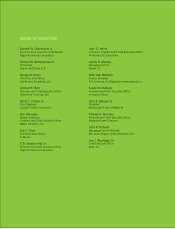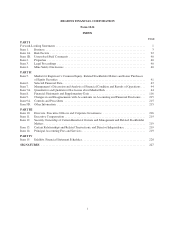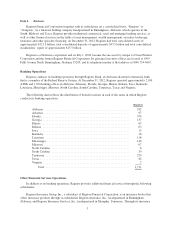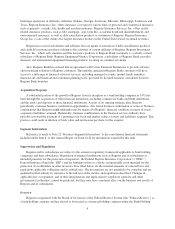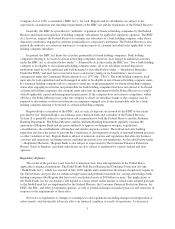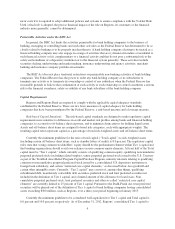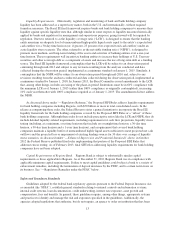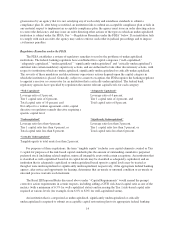Regions Bank 2012 Annual Report Download - page 23
Download and view the complete annual report
Please find page 23 of the 2012 Regions Bank annual report below. You can navigate through the pages in the report by either clicking on the pages listed below, or by using the keyword search tool below to find specific information within the annual report.capital distribution unless it will meet all minimum regulatory capital ratios and will have a ratio of Tier 1
common equity to risk-weighted assets of at least 5% after making the distribution. The rules also provide that
the Federal Reserve may object to a capital plan if the plan does not show that the covered bank holding
company will maintain a Tier 1 common equity ratio of at least 5% on a pro forma basis under expected and
stressful conditions throughout the nine-quarter planning horizon covered by the capital plan. Covered bank
holding companies, including Regions, may execute capital actions such as paying dividends and repurchasing
stock only in accordance with a capital plan that has been reviewed and approved by the Federal Reserve. The
CCAR rules, consistent with prior Federal Reserve guidance, provide that capital plans contemplating dividend
payout ratios exceeding 30% of after-tax net income will receive particularly close scrutiny.
The Proposed SIFI Rules, discussed earlier in this section under “Enhanced Supervision and Prudential
Standards,” proposed to expand the stress testing requirements to include, among other things, stress testing by
the Federal Reserve under three economic and financial scenarios: baseline, adverse and severely adverse
scenarios. In October 2012, the Federal Reserve published final rules implementing that portion of the Proposed
SIFI Rules expanding the stress testing requirements. Also, we are required to conduct our own semi-annual
stress analysis (together with the Federal Reserve’s stress analysis, the “Stress Tests”) to assess the potential
impact on Regions, including our consolidated earnings, losses and capital, under each of the economic and
financial conditions used as part of the Federal Reserve’s annual stress analysis. The Federal Reserve may also
use, and require companies to use, additional components in the adverse and severely adverse scenarios or
additional or more complex scenarios designed to capture salient risks to specific lines of business. Regions Bank
is also required by final Federal Reserve rules to conduct annual stress testing and report the results to the
Federal Reserve.
Under the Federal Reserve’s guidance, the CCAR annual process for 2013 will be implemented in
conjunction with the stress testing requirements described above. A summary of results of the Federal Reserve’s
analysis under the severely adverse stress scenario will be publicly disclosed, and the bank holding companies
subject to the rules, including Regions, must disclose a summary of the company-run severely adverse stress test
results. Regions is required to include in its disclosure a summary of the severely adverse scenario stress test
conducted by Regions Bank using the scenarios defined by the Federal Reserve. Regions submitted its 2013
CCAR rule capital plan to the Federal Reserve on January 7, 2013 and the Federal Reserve committed to
responding by March 14, 2013.
Living Will Requirement. As required by the Dodd-Frank Act, the Federal Reserve and the FDIC have
jointly issued a final rule that requires certain organizations, including each bank holding company with
consolidated assets of $50 billion or more, to report periodically to regulators a plan (a so-called “living will”)
for their rapid and orderly resolution in the event of material financial distress or failure. Regions’ resolution plan
must, among other things, ensure that our depository institution subsidiary is adequately protected from risks
arising from our other subsidiaries. The final rule sets specific standards for the resolution plans, including
requiring strategic analysis of the plan’s components, a description of the range of specific actions the company
proposes to take in resolution, and a description of the company’s organizational structure, material entities,
interconnections and interdependencies, and management information systems, among other elements. The plan
must be submitted annually for review to the Federal Reserve and the FDIC.
In addition, the FDIC has issued a final rule that requires insured depository institutions with $50 billion or
more in total assets, such as Regions Bank, to submit to the FDIC for review periodic contingency plans for
resolution in the event of the institution’s failure. The rule requires these insured institutions to submit a
resolution plan that will enable the FDIC, as receiver, to resolve the bank in a manner that ensures that depositors
receive access to their insured deposits within one business day of the institution’s failure, maximizes the net-
present-value return from the sale or disposition of its assets, and minimizes the amount of any loss to be realized
by the institution’s creditors. The final rule also sets specific standards for the resolution plans, including
requiring a strategic analysis of the plan’s components, a description of the strategies for achieving the least
7



